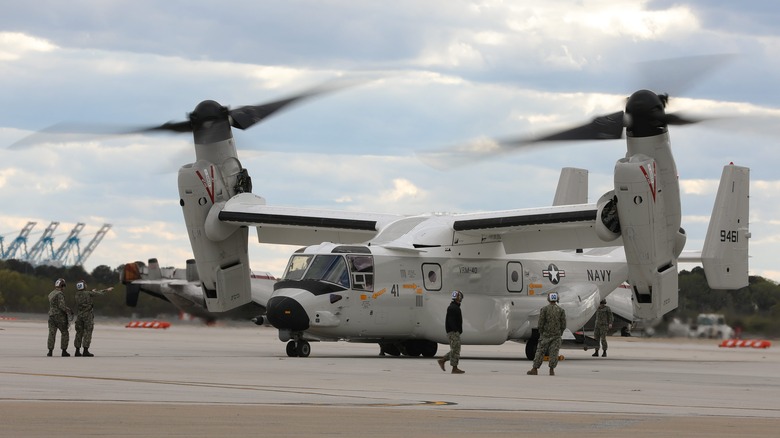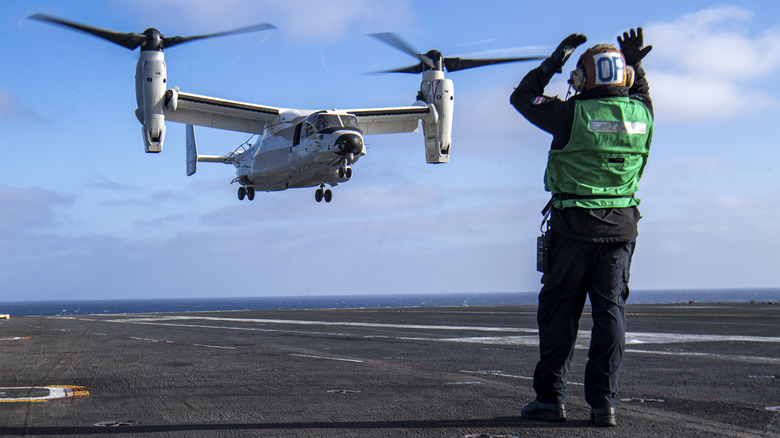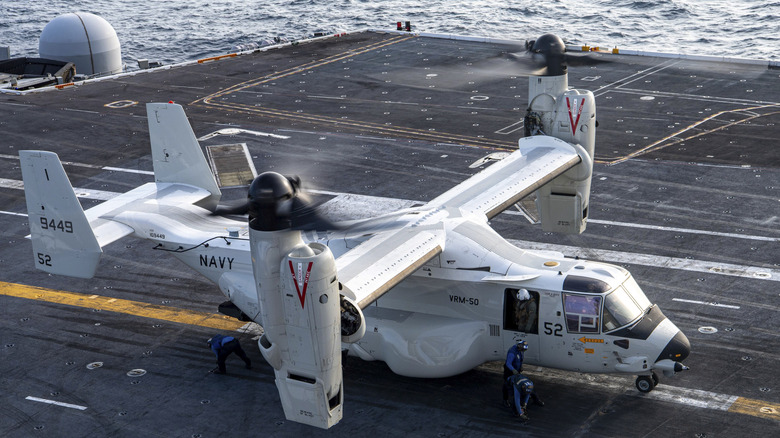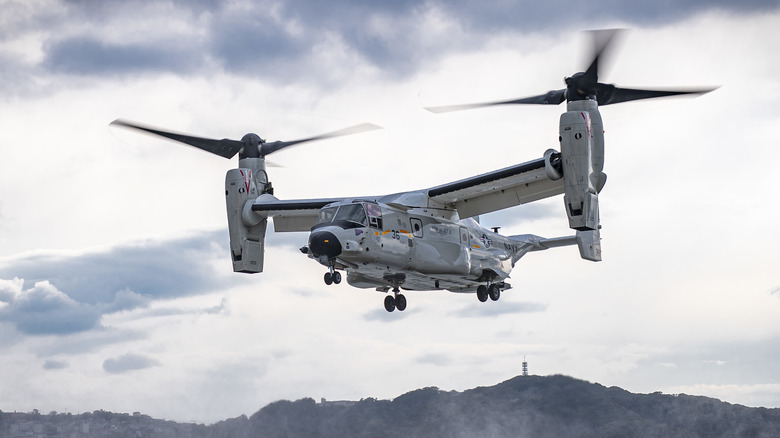Here's What The Navy's New CMV-22B Osprey Can Do
On April 16th, the U.S. Navy received its first CMV-22B at Naval Air Station (NAS) Norfolk. This aircraft, joining the fleet under the Fleet Logistics Multi-Mission Squadron (VRM) 40, nicknamed "Mighty Bison," will begin to handle logistics missions for U.S. naval operations in the Atlantic come 2025, with more CMV-22Bs are expected to be delivered to fill the rank of the unit this summer.
The day's been a long time coming for the Navy. Despite achieving Initial Operation Capability (IOC) certification in 2021, the tilt-rotor fleet faced several major challenges, from technical issues to a series of high-profile incidents involving Osprey aircraft, leading to a fleet-wide grounding in 2023. As such, the delivery of this first aircraft is a pretty significant (and encouraging) milestone for the program as a whole.
Now, you might be curious in what way is the CMV-22B so different from the V-22 that it gets an entirely new designation from the U.S. military. There are quite a few new things with this new member of the V-22 family: besides modifications to the airframe and fresh electronics, Bell-Boeing has also done a lot of work on the design of the CMV-22B so that it can take over the vital Carrier Onboard Delivery (COD) mission that the Navy is planning for it to take over from the aging fleet of C-2 Greyhound.
How Bell-Boeing Made the CODsprey
The CMV-22B was purpose-built as a carrier logistics platform. As such, it was affectionately given the nickname "CODsprey", in honor of its specialized mission. To give it the extra range required to meet the Navy's requirement, the airframe is expanded with two auxiliary fuel bladders at the front of the sponsons. The extra juice enables the CMV-22B to cover a range of up to 1,150 nautical miles, surpassing the Marine Corps MV-22B's range of 879 nautical miles, while carrying either five tons of cargo or 23 passengers. Notably, it also has the lifting power to transport a complete F-35 engine to and from a carrier.
Bell-Boeing also gave the CMV-22B a better communication system to help it take to friendly ships at sea by way of an over-the-horizon high-frequency (HF) radio. It also gets a Link 16 datalink package, plus an Iridium satellite phone as a backup in case the HF radio fails. Cargo handling got an upgrade too, with a new lighting system in the loading area for easier on/off-load by sailors and an intercom system for direct communication between pilots and passengers when needed.
Operating at sea comes with inherent risks, so the CMV-22B is fitted with a rapid fuel-dump system to quickly shed its weight in emergencies. Its back ramp should also support a probe-and-drogue aerial refueling kit, which has been used with the Marine's MV-22B for years. The aircraft should have no issue handling aerial refueling ops in a pinch, too.
Why The Navy Is Replacing the C-2 Greyhound with the CMV-22B
Since the 1960s, the C-2 Greyhound has dutifully served as the U.S. Navy's carrier courier, shuttling supplies, mail, and personnel between ports and underway fleets. While reliable, the C-2 faces a fundamental challenge: it's a fixed-wing aircraft. That means it has to be launched using catapults from flat decks, then land using arrestor hooks. Cargo coming off the C-2, if it has to be delivered to smaller ships in the fleet, must then be flown off to where it's needed by a helicopter, such as an MH-60 Seahawk.
This double trip not only consumes significant fuel and manpower but also crucial time, especially during emergencies such as medical evacuations. Yet, good alternatives to the C-2 were non-existent — while heavy-lift helicopters like the CH-53 Sea Stallion existed, they lacked the range to take over the C-2's role.
That was until the Joint-Service Vertical Take-Off/Landing Experimental (JVX) program introduced the V-22 Osprey in 1981, which combined the vertical takeoff and landing capability of helicopters with the speed and range of fixed-wing planes. It seemed like the perfect replacement for the C-2. The Navy wasn't initially sold on the Osprey, but fortunately, the Osprey found its use with the Marine Corps as the MV-22B, delivering cargo and marines from amphibious ships to shore. It was not until 2009 that ideas of using tilt-rotors as a COD platform took root in the Navy, and work on the CMV-22B began from there.
The Uncertain Future of the CMV-22B in the Fleet
Despite its promising capabilities on paper, the CMV-22B program has faced significant challenges since achieving IOC in 2021. Originally expected to reach full operational capability in 2023, the program encountered setbacks, including the grounding of the Osprey fleet that same year. Adding to these difficulties, a harsh report from the Director of Operational Test and Evaluation (DOT&E) in 2022 pointed out numerous subsystem failures, including a troublesome ice protection system responsible for a whopping 44% of failures during testing. Additionally, the CMV-22B received a poor score for ease of maintenance, necessitating frequent special inspections to keep it airworthy.
As such, while the Osprey family is positioned to become a central part of the Navy's future fleet structure, the C-2 Greyhound had to fill in for it in 2023 when the fleet-grounding order came out. Despite the grounding order being lifted this past March, the brief episode still put a lot of doubt on not only the punctuality of the CMV-22B's program but also the viability of the platform as a whole.
Overall, while tentative plans exist to press the CMV-22B into service in 2025, that milestone is all but certain. The date for full transition will ultimately depend on Bell-Boeing's ability to address the problems identified by the DOT&E in 2022, which we'll be able to learn once the DOT&E releases its follow-up report on the CMV-22B this coming June.



